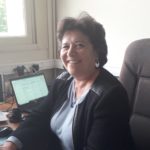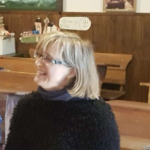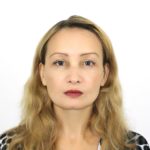 |
Chair:
Nicole Vilmer SC D (France), 2024 – 2028* (nicole.vilmer – at – obspm.fr) |
 |
Vice-Chair:
Agnieszka Gil-Swiderska SC D (Poland), 2024 – 2028* (gila – at – uph.edu.pl)
|
 |
Vice-Chair:
Jie Zhang SC D (USA), 2024 – 2028* (jzhang7 – at – gmu.edu)
|
Intercommission/Panel/Task Group Liaisons:
PCB: Asti Bhatt (USA), 2022 – 2026
PCB: Katariina Nykyri (USA), 2022 – 2026
PEX: Lev Zelenyi (Russia), 2024 – 2028
PRBEM: Yihua Zheng (USA), 2024 – 2028
PSW: Insoo Jun (USA), 2022 – 2026
PSW: Drew Turner (USA), 2024 – 2028
Terms of Reference
Commission D deals with the study of the different natural plasmas in the solar system obtained from many space missions. It includes the study of the plasma in the whole heliosphere including the boundary with the interstellar medium, the connection beween solar and heliospheric plasmas, the magnetospheric plasmas and in association with commission C the link with active plasma experiments. Data include both electromagnetic radiation in the whole spectrum, in-situ measurements of plasma parameters and detection of energetic particles.
Sub-Commission D1: The Heliosphere
Chair:
Konstantin Herbst (Germany), 2024 – 2028* |
|
Vice-Chairs:
Jingnan Guo (China), 2024 – 2028
Jacob Heerikhuisen (New Zealand), 2024 – 2028*
Athanasios Papaioannou (Greece), 2024 – 2028* |
|
Terms of Reference
Sub-Commission D1 focuses on heliospheric research, aiming to provide a lively forum for space scientists to report, discuss, and compare their observations, theories, and models.
Potential research topics include the solar wind; the heliospheric magnetic field; the effects of solar activity on cosmic rays and the heliosphere, global merged interaction regions, interplanetary shocks (together with D2), pick-up ions, neutral particles, the transport and acceleration of energetic particles and cosmic rays (including the anomalous component), anisotropies, and the composition of various components. Also covered is the heliosheath: heliospheric structure and the transition to interstellar space (including the termination shock, heliopause, and bow wave/possible bow shock) and the long-term interaction with different interstellar environments and its effect on Earth.
The sub-commission does not cover the Sun as a star, the Sun as the source of the solar wind/solar energetic particles/interplanetary magnetic field, and the transition from the Sun to the heliosphere and magnetospheres. They are topics of sub-commissions E2, D2/E3, and D3, respectively.
Back to top
Sub-Commission D2/E3: The Transition from the Sun to the Heliosphere
 |
Chair:
Olga Khabarova (Luxembourg), 2024 – 2028*
(olga.khabarova – at – uni.lu) |
| |
Co-Vice Chairs:
Silvano Fineschi (Italy), 2024 – 2028*
Susanna Parenti (France), 2024 – 2028*
|
Terms of Reference
(1) Observational and theoretical study of the phenomena of the quiet and active sun in the photosphere, chromosphere, and corona that relate to energy release in form of coronal heating, solar wind acceleration, energetic particle generation, flares and coronal mass ejections.
(2) Observational and theoretical study of the subsequent phenomena in the inner heliosphere and of the processes governing its structure, such as fast and slow solar wind streams, interplanetary coronal mass ejections and shock waves, solar energetic particles, corotating interaction regions including their space weather effects.
Sub-Commission D2/E3 deals with the quiet and active Sun and its atmosphere expanding in a form of the thermal solar wind and accelerating charged particles to suprathermal energies via numerous dynamical processes. The sub-commission goal is to support studies of the processes associated with dynamics of the solar layers that fill the heliosphere with multi-scale plasma and magnetic structures and energetic particles. Their propagation through the interplanetary medium structures the interplanetary space, and their variations, which determine the terrestrial environment, are the key drivers of space weather phenomena.
The sub-commission topics cover the following observational and theoretical studies:
- Quiescent Sun, solar wind formation and acceleration.
- The quiet and disturbed solar wind. Solar-terrestrial couplings.
- Processes in the photosphere, chromosphere, and corona related to energy release leading to coronal heating, as well as transient phenomena associated with flares, coronal mass ejections, solar energetic particles and solar cosmic rays.
- Propagation of transient solar structures and accelerated particles into the heliosphere and their interaction with the ambient magnetic field and the solar wind plasma. Temporal and spatial properties of magneto-plasma structures in the heliosphere.
- Ground and space observations, including multi-point, of the Sun and the solar wind and new approaches to big data processing to address the items listed above.
Sub-Commission D3: Magnetospheres
Chair:
Yuri Shprits (Germany/USA), 2024 – 2028* |
|
Vice-Chair:
Hayley Allison (United Kingdom), 2022 – 2026
Elena Grigorenko (Russia), 2022 – 2026
Katariina Nykyri (USA), 2024 – 2028*
Intercommission/Panel Liaisons:
PRBEM: Yuri Shprits (Germany/USA), 2018 – 2022 |
|
Terms of Reference
Sub-Commission D3 concentrates on research of the planetary magnetospheres, the regions of space in the planetary neighborhoods where the planet’s magnetic field and/or ionosphere deflects the solar wind flow. The aim is to understand the nature of the coupling between the solar wind and the planetary magnetosphere, ionosphere, upper atmosphere and/or regolith controlling the structure and dynamics of these plasma systems. Special emphasis is paid to processes common to all planets, such as the nature of charged particle acceleration processes, magnetic reconnection, and transport of mass, momentum, and energy through these systems. The existence and controlling factors for dynamic processes producing analogues to the terrestrial geomagnetic storms and substorms are investigated.
Back to top
Sub-Commission C5/D4: Theory and Observations of Active Experiments
Chair:
Asti Bhatt (USA), 2022 – 2026* |
|
Vice-Chair:
Eliana Nossa (USA), 2022 – 2026* |
|
Terms of Reference
The Sub-Commission on Active Experiments promotes research involving the active perturbation of laboratory plasmas as well as space plasmas to enhance the understanding of the natural space plasma environment and the interaction of space vehicles with this environment. Some of the active perturbations used in these investigations include (1) tethered satellites, (2) VLF transmitters, (3) charged particle beam injections (4) chemical releases and (5) high-power radio waves. A wide variety of diagnostics are used to isolate physical processes found in actively perturbed space plasmas. Ground-based space plasma experiments rely heavily on radar and optical observations. Space-based experiments rely on diagnostics such as in situ electric field and charged particle measurements. Important physical processes in space plasmas studied with active experiments include plasma turbulence, wave-particle interactions, wave-wave interactions, and plasma resonances. Physical processes studied associated with spacecraft environmental interactions include vehicle charging and plasma wakes and turbulence produced by vehicles passing through the charged media in space.
Back to top
* (after officer term) = second and final term in the office indicated